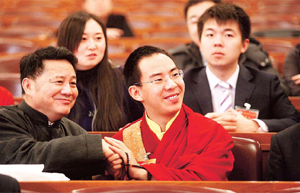Full Text: Report on central, local budgets
(Xinhua)
Updated: 2010-03-16 16:23
2) Total expenditures on education amounted to 198.139 billion yuan, 100% of the budgeted figure and an increase of 37.769 billion yuan or 23.6%. This sum consisted of 56.762 billion yuan in central government spending and 141.377 billion yuan of transfer payments to local governments. A total of 66.61 billion yuan was spent on reforming the system for guaranteeing the costs of rural compulsory education. All of the country's approximately 150 million rural students were exempted from paying tuition and miscellaneous fees and supplied with free textbooks. In the central and western regions, around 11.2 million rural students receiving compulsory education whose families have financial difficulties received subsidies enabling them to live in school dormitories. Urban students receiving compulsory education were exempted from paying tuition and miscellaneous fees. The central government supported cities in solving the problem of providing education to 8.8 million children of rural migrant workers, and provided 5.17 billion yuan in subsidies so that children who met local government conditions for school enrollment were exempted from paying tuition, miscellaneous fees, and non-resident surcharges. The policy to link the pay of compulsory education teachers with their performance was steadily implemented. We launched the national project to make primary and secondary school buildings safe, and spent 8 billion yuan on renovating 120 million square meters of school buildings. We spent 1.13 billion yuan on the construction of vocational education training facilities. We exempted tuition for approximately 4.26 million rural students in secondary vocational schools whose families have financial difficulties and students who are studying agriculture-related majors, and provided 2.4 billion yuan in subsidies to cover these costs. A total of 16.23 billion yuan was spent on providing government scholarships and grants to about 4.7 million college students and 11.2 million secondary vocational school students who are outstanding both academically and morally and whose families have financial difficulties. Beginning on September 1, 2009, the standard ordinary scholarship for PhD students at central government institutions of higher learning was raised from 240-280 yuan per month to 1,000 yuan per month. We launched a pilot project to reduce the debt burden of central government institutions of higher learning and provided 10.3 billion yuan for that purpose. We spent 42 billion yuan on the 211 Project and other projects to promote the development of higher education.
3) Expenditures on medical and health care reached 127.714 billion yuan, 108.2% of the budgeted figure and an increase of 42.269 billion yuan or 49.5%. The over-budget amount was mainly concentrated on community-based medical and health care. This sum consisted of 6.35 billion yuan of central government spending and 121.364 billion yuan of transfer payments to local governments. The central government spent 116.2 billion yuan on supporting the reform of the pharmaceutical and healthcare systems. A total of 830 million people were covered by the new type of rural cooperative medical care system, and 180 million urban residents participated in the basic medical insurance system for non-working urban residents, with subsidies reaching 80 yuan per person. We supported retirees from closed or bankrupt state-owned enterprises who were not covered by medical insurance in subscribing to basic health insurance for local urban workers. We increased medical assistance in both urban and rural areas, and provided financial assistance for urban and rural residents experiencing financial hardship to enable them to subscribe to medical insurance and reduce their burden of medical expenses. We implemented a system for basic drugs in 30% of community-level medical institutions. We improved the community-based medical and health service system, and supported the construction of 29,000 hospitals and 5,000 central hospitals in towns and townships. We set up a sound mechanism for guaranteeing funding for basic public health services in urban and rural areas, and implemented major public health service programs.
4) Expenditures on social security and employment work amounted to 329.666 billion yuan, 98.4% of the budgeted figure and an increase of 55.307 billion yuan or 20.2%. The surplus was mainly from less spending on disaster relief than the budgeted figure at the beginning of 2009. This sum consisted of 45.436 billion yuan of central government spending and 284.23 billion yuan of transfer payments to local governments. Expenditures on social security came to 290.575 billion yuan, an increase of 41.424 billion yuan or 16.6%. Trials of the new old-age insurance system for rural residents were carried out in 320 counties. Subsistence allowances for urban and rural residents increased by 15 and 10 yuan per month per person respectively, with total expenditures of 54.085 billion yuan. We provided one-off living allowances to over 75.7 million poverty-stricken people in urban and rural areas throughout the country, with expenditures of 9.067 billion yuan. We provided 132.629 billion yuan for old-age pension funds of enterprises, launched pilot projects to fully fund enterprise employees' personal accounts for basic old-age pensions, continued to raise basic pension benefits for enterprise retirees with a focus on special groups, and established a system of basic old-age insurance at the provincial level throughout the country. We increased allowances for entitled groups, bringing total allowances to 17.3 billion yuan.


